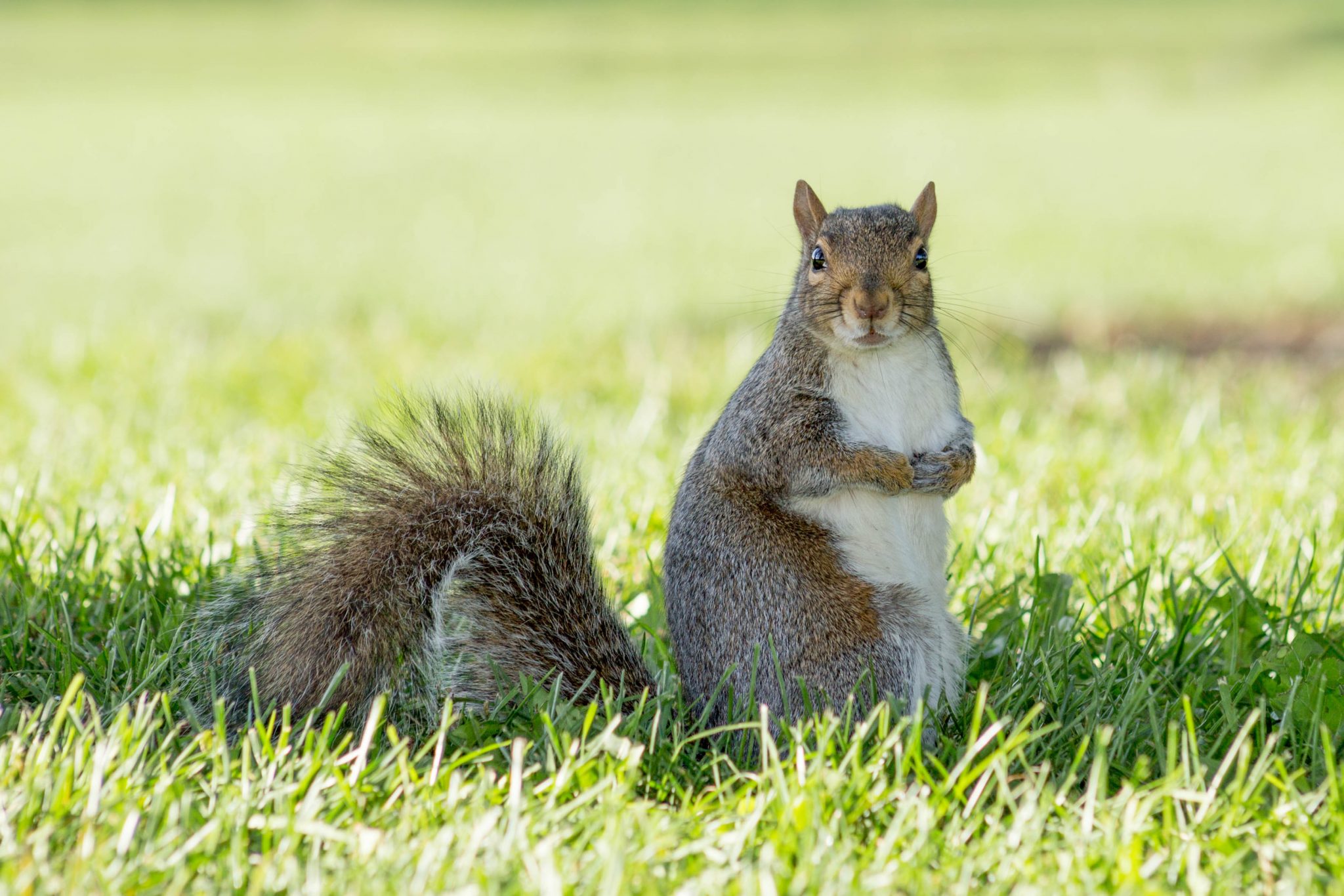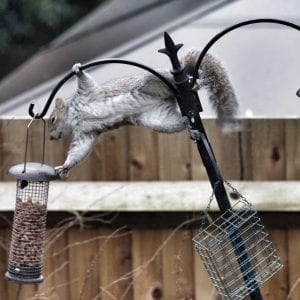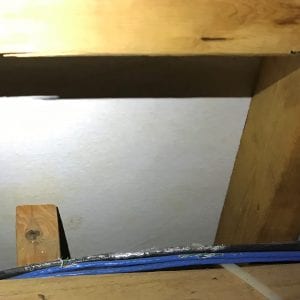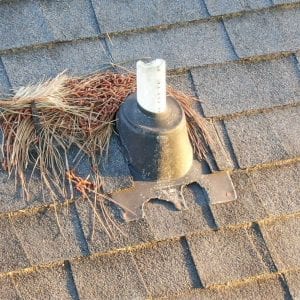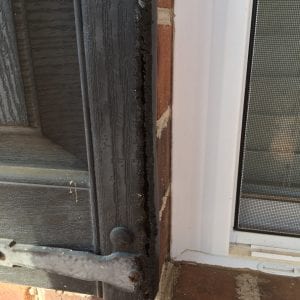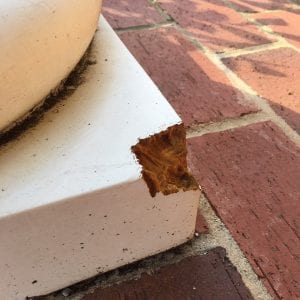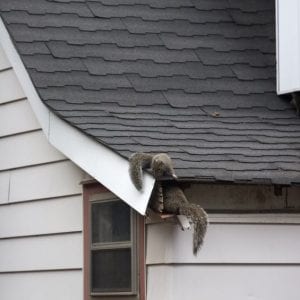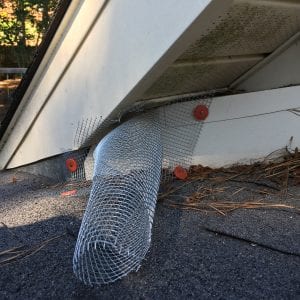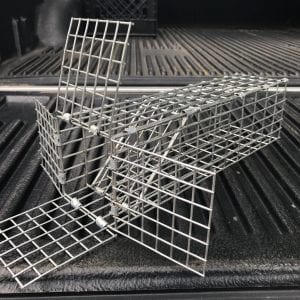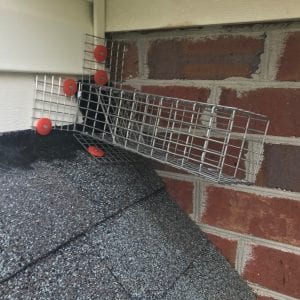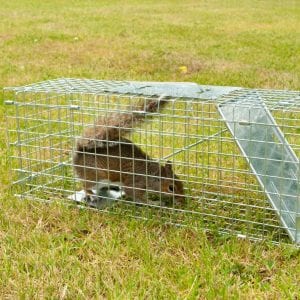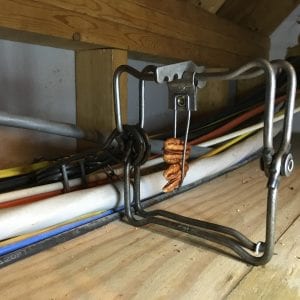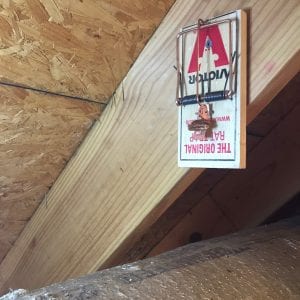Forestry & Wildlife

Know how to identify specific problems associated with gray squirrels and learn the recommended management strategies for homeowners.
The eastern gray squirrel (Sciurus carolinensis) is one of most recognizable squirrel species in Alabama (figure 1). They are found in a wide variety of habitats from urban landscapes to woodlands. They are popular as a game species and among wildlife viewing enthusiasts. In addition, gray squirrels provide an important ecological benefit in the dispersal and propagation of seeds.
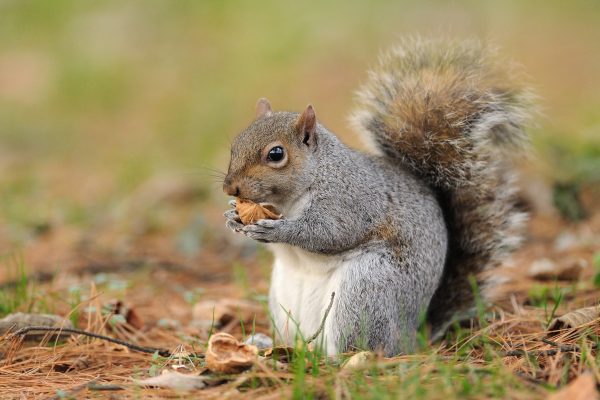
Figure 1. Eastern gray squirrel
Gray squirrels can become a problem to homeowners when they cause nuisance issues such as eating from bird feeders, scaring away birds, damaging homes or property, and caching food in attics or barns. Managing nuisance gray squirrels can be a time-consuming and difficult task that requires much patience.
Before beginning a squirrel management strategy, it is important to set realistic goals for what is considered effective management. In most cases, complete eradication and permanent removal of squirrels is unrealistic simply due to reproduction and immigration from other populations. As individual squirrels are removed from a population, others quickly move in to fill the void. In addition, gray squirrels breed twice a year (February/March and July/August) and typically have two to four young in a litter. These two factors make squirrel control and damage reduction a realistic goal over eradication for most nuisance issues addressed here.
Common Squirrel Damage Issues
Squirrel Foraging Damage
Gray squirrels spend much of their time foraging for food, which results in frequent conflicts with humans. Squirrels cause issues to homeowners as they feed on hard and soft mast trees, such as pecans and ornamental fruit trees.
Squirrels are considered “scatter-hoarders,” which describes their instinctual habit of creating caches of stored food. Establishing new caches and accessing previously established ones in lawns can cause holes and damage to turf. In addition, squirrels will feed on plant blossoms and bulbs, severely damaging or killing ornamental plants.
Many people who enjoy feeding birds eventually have issues with squirrels eating seeds from the feeder. This can deter birds from feeding and often increases feeding costs (figure 2).
- Figure 2. Eastern gray squirrel on bird feeder
- Figure 3. Wiring gnawed by squirrels
- Figure 4. Roof vent gnawed by squirrels
Gnawing
One of the most noticeable problems caused by gray squirrels is their habit of gnawing on houses, garages, and other buildings. Just like other rodents, squirrels gnaw on a wide range of materials to maintain their constantly growing teeth. This is most problematic when squirrels gnaw on the wiring inside homes and even automobiles and machinery. Exposed wiring in the home is a potential fire hazard (figure 3) and can cause a multitude of failures with automobiles and machinery.
Another common issue with gray squirrels is their gnawing on the lead boots that cover vent pipes coming from the roof (figure 4). Lead is a soft metal, which is an enticing tooth sharpener for squirrels. Water leaks into the attic can form if squirrels gnaw the lead boot extensively. Squirrels also can gnaw the soft aluminum tie wires on chain link fences.
Other squirrel gnawing may simply cause esthetic issues and aggravation when they gnaw siding, shutters, or columns of houses (figures 5 and 6). This can result in costly repair for the homeowner.
Gray squirrels also potentially gnaw on trees. This damage could be minimal and only impact branches and limbs, or it could be more severe. Gnawing on bark around the entire base of younger trees could result in girdling and cause tree mortality.
- Figure 5. Shutters gnawed by squirrels
- Figure 6. Columns gnawed by squirrels
- Figure 7. Eastern gray squirrels entering through soffit
Openings\Nesting
Gray squirrels construct nests of twigs and leaves or use a tree cavity. This cavity nesting instinct causes squirrels to nest in the attics of homes or secure locations in garages and barns.
Attic spaces are warm, dry, and typically free from predators. Plus, insulation found in attics makes ideal nesting material for young squirrels. Squirrels often will chew through siding, soffit, and fascia boards to enter attics and wall spaces (figure 7). It is not uncommon to find remnants of previous meals or caches of pecans, seeds, and other nuts stored in human structures.
Health and Safety Concerns
Beyond the threat of gnawed wiring, squirrels in a home can cause other health and safety risks. Squirrels have the potential to carry parasites, such as fleas and ticks, which can pose a threat to humans. Gray squirrels also can be impacted by mange; however, the mites that impact squirrels typically have little to no impact on humans or pets.
Tree squirrel botflies (Cuterebra emasculator) will use squirrels as a host for its parasitic larvae. The larvae develop under the skin and cause an unsightly lump. The developing larvae on a squirrel can look very disturbing; however, the larvae will not move between the host and others (i.e., squirrel to squirrel or squirrel to other mammal) and does not pose any threats to humans or pets.
Extended use of an attic space by squirrels can result in the buildup of feces and urine, which can be absorbed into boards and insulation. This can cause staining, odors, and the potential for bacteria growth. It is important to clean up any waste deposits quickly before these issues occur.
Control Options
Options for controlling gray squirrel damage can be divided into nonlethal and lethal methods. Nonlethal strategies include exclusion, live traps, and repellents. Lethal control includes shooting and lethal trapping. An effective management strategy oftentimes requires the use of multiple control options.
It is important to check your local wildlife laws and regulations before developing a lethal management strategy. In most states, gray squirrels are considered a game species with a specific season. According to the wildlife regulations in Alabama, homeowners are allowed to remove one nuisance gray squirrel out of season without a permit (Alabama Department of Conservation and Natural Resources Administrative Code, Chapter 220-2-27).
A homeowner may need a depredation permit if looking to dispatch multiple squirrels out of season. These permits can be obtained from an Alabama Department of Conservation and Natural Resources district office (www.outdooralabama.com/wildlife-section). If outside of Alabama, contact your county Extension office or your state’s Department of Conservation for clarification on local wildlife regulations.
Exclusion
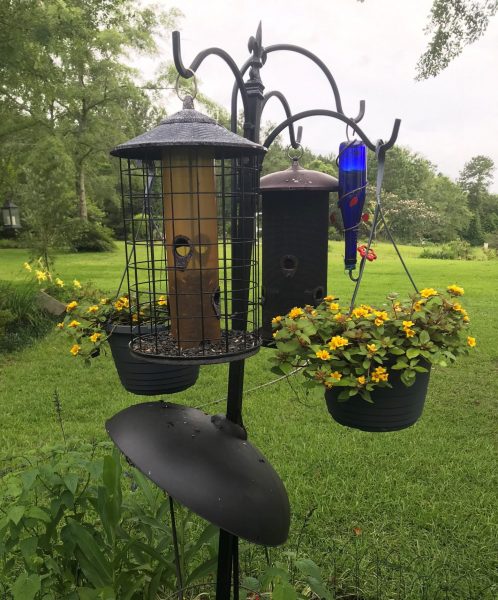
Figure 8. Bird feeder baffle
Ideally, the best method to control squirrels entering into a space is through exclusion. In some situations, preventing the nuisance squirrel from accessing an area could eliminate the behavior and reduce damage. Squirrels are excellent jumpers and are able to jump up to 4 feet vertically and twice that distance horizontally. To limit access, homeowners can keep trees and overhanging branches at least 8 feet from buildings and feeders.
Many commercially available feeders are equipped with a baffle, or umbrella-shaped piece of metal or plastic around the pole (figure 8). This attachment is designed to exclude squirrels from the feeder; however, squirrels often are able to overcome this obstacle and still access the feeder. Other options include feeders that are enclosed in steel cages (figure 8) that allow smaller birds to feed but exclude squirrels. Polybutenes are a sticky polymer substance that can be applied to structures to discourage climbing; however, these products can be messy to use.
Another option available to reduce squirrels’ attraction to feed from ornamental bird feeders or plants is to create a sacrificial feeder away from other bird feeders and your home. A simple platform feeder baited with shelled- cracked corn or peanuts, or even dried whole-ear corn, provides a cheaper feeding alternative to deter squirrels from eating from ornamental bird feeders.
If squirrels have taken residence in a building, the first step is to identify their entrance into the structure. Loose pieces of siding or holes in eaves/soffits or even ridge vents make ideal locations for squirrels to enter a structure. If the home is on a crawl space, squirrels may be entering from underneath the home and climbing vertically into the attic.
One-way funnels can be created out of 1⁄4-to-1⁄2-inch heavy wire mesh (figure 9) or commercially available one-way doors (figures 10 and 11), which can be attached to the hole and allow the squirrel to leave the structure but not reenter. Another avenue is to attach a box trap adjacent to the hole that allows the squirrel to leave the structure but then be caught in the trap. It is important to remember that juveniles remain in the nest for 10 to 12 weeks before they are weaned; therefore, excluding the parents during this time could result in mortality for the juveniles left inside the structure. Once all squirrels are removed, exclusion devices should be installed to prevent reentry, or the entry holes must be permanently repaired.
Squirrels are diurnal, meaning they are most active during the day. They can be found foraging for food just before daylight, for several hours into the morning, and during the last several hours of late afternoon until dusk. They typically rest in midday, but during the fall they may spend most of the day foraging for and storing acorns. This should be considered when setting up exclusion devices or traps. Installing exclusion devices or sealing the entrance hole in the middle of the day or night, thus not allowing the squirrel to still leave the space, could result in trapping the squirrel inside the space.
- Figure 9. Squirrel exclusion cone
- Figure 10. One-way exclusion door
- Figure 11. One-way exclusion door installed
Repellents
Chemical repellents require the application of a substance that negatively stimulates one of the squirrel’s senses resulting in a change in behavior. For example, capsaicin is made from hot peppers and can be used as a repellent on birdseed to prevent consumption or on feeders to prevent gnawing. In birds, the main taste receptor nerve, the trigeminal nerve, is less developed than in mammals, so birds are much less sensitive to capsaicin. Examples of other repellent ingredients are garlic, peppermint oil, naphthalene, eggs, and predator urine.
It is important to reference the label before using a particular product. The success of repellents can vary between uses and often will need to be used in combination with other management strategies.
Shooting
The use of firearms to dispatch gray squirrels can be an effective management strategy when proper shot placement can ensure a humane death. The use of shotguns (numbers 6, 7 1⁄2, or 8 shot), a .22 caliber rifle, and a .177 caliber air rifle will provide efficient and effective euthanasia. Most city ordinances, however, prevent the discharge of firearms within city limits; this may or may not include air rifles. As a result, this method may not be a sufficient management strategy for everyone. It is important to check with local law enforcement before using shooting as a management strategy.
Trapping
Nuisance squirrels also can be removed through trapping. Wildlife traps are broken into two categories, lethal and nonlethal, and require special considerations to be taken by the user.
Nonlethal traps, such as small box traps (figure 12) or glue traps, catch and hold the animal. In addition to being required by Alabama wildlife regulations, these traps should be checked at least every 24 hours to ensure the ethical and humane treatment of the captured animal. Considerations also should be made in advance by the homeowner on how the animal will be handled after trapping. If the squirrel is released outside of the home and the entrance hole has not been effectively sealed, it is highly likely that the animal will reenter the building. In addition, the squirrel may become trap shy and much more difficult to catch again.
Most states have wildlife regulations in effect that prevent transporting the live squirrel to another site and releasing. In Alabama (Alabama Department of Conservation and Natural Resources Administrative Code, Chapter 220-2-27), trapped animals such as squirrels may not be relocated across a county line or a major river drainage. However, it is unadvisable to relocate a trapped animal in general due to the risk that a nuisance animal might pose to others as well as the increased stress and harm it causes to the animal itself.
- Figure 12. Box trap
- Figure 13. Body-gripping trap number 110
- Figure 14. Snap trap
In some areas, community animal control officers or state conservation agencies will remove and dispatch the squirrel. However, if none of these options is available to the homeowner, the best avenue for the homeowner and the nuisance squirrel is often the quick and humane euthanasia of the animal. Extreme caution should be used to prevent bites and scratches from a live animal when preparing for release or euthanasia.
Lethal traps are designed to dispatch the animal quickly and humanely when the trap is triggered. This trapping method usually removes the homeowner’s responsibility to dispatch the animal. Effective lethal traps for gray squirrels include large, rat-size snap traps and number 110 body-gripping traps (figure 13).
Both trap styles can be used in combination with a bait to increase effectiveness. Baits can include shelled pecans, peanuts, peanut butter, peanut butter and oatmeal, other types of nuts, or dried fruit. Body grip traps can be set without bait in a spot where the squirrel is already travelling or is restricted and has to push through the trigger. A good example would be near an entrance hole or on a railing or beam.
When setting lethal traps, it is important to set the trap in areas that squirrels frequent most. Snap traps can be set horizontally and fastened by a screw or nail to rafters or attic decking. This will ensure that the trap remains in the same place after being triggered. In addition, snap traps can be set vertically (figure 14) to encourage the squirrel to stand on its hind legs and reach up for the bait, potentially increasing the catch potential and reducing trap misfires.
Toxicants
At the time of this article, there are no known fumigants or toxicants labeled for squirrels. All pesticides are marketed with a label that provides the legal uses for the product. If use on squirrels is not listed on the label, this product cannot be used legally. For example, moth balls or rodenticides for mice or rats are not labeled for use in squirrel control and cannot be used for this method.
Unconventional Strategies
Sounds and lights are methods that are sometimes utilized as an immediate deterrent or harassment but not as a long-term management solution. Even though audio and visual deterrents might provide only temporary relief, it might harass the squirrel out of a structure and give the homeowner an opportunity to seal the entrance hole. Ultrasonic devices claim to use high-frequency sound waves to deter pests and are marketed for squirrel use; however, no scientific research has been able to prove these as an effective management tool.
Euthanasia
When determining the appropriate method to euthanize a trapped squirrel, it is important to consider both human safety and animal welfare. The animal should be euthanized quickly and humanely to reduce animal pain and stress as well as to minimize human emotional and physical risk.
The American Veterinary Medical Association (AVMA) sets guidelines for the welfare of animals and appropriate euthanasia methods with consideration of current science and ethics. For more information, reference the AVMA Guidelines for the Euthanasia of Animals: 2020 Edition at www.avma.org/sites/default/files/2020-01/2020-Euthanasia-Final-1-17-20.pdf. It is advisable to check with your local Department of Conservation, county Extension office, or a professional nuisance wildlife control operator for the most appropriate method to euthanize a trapped squirrel.
Professional Services
For most homeowners, the first option for managing a nuisance gray squirrel would be to hire a licensed nuisance wildlife control operator (NWCO) or trapper. This service comes with a fee to the homeowner and can vary depending on factors such as accessibility, number of traps, and carcass disposal.
NWCOs often can assist in cleanup and repairs of any damage that might have been caused by squirrels. Contact your county Extension office or Department of Conservation for a list of nuisance wildlife control officers that service your area.
It is important to outline the scope of work with the professional and understand all fees ahead of hiring. If possible, have a contract outlining these things prior to the job being started. Lastly, check references prior to hiring and be sure the contractor is bonded and licensed.
Carcass Disposal
It is important to take safety precautions when handling and disposing of squirrel carcasses. It is recommended that you wear gloves, avoid bodily fluids, such as blood, saliva, and urine, and wash your hands with warm, soapy water after disposal.
City ordinances can vary on the disposal of a carcass. Some municipalities allow for disposal in common household garbage or require that the carcass be disposed of with other biohazardous materials. Other avenues for carcass disposal include burial and incineration. Follow all state and city ordinances when determining the best avenue for carcass disposal.
Repairs and Cleanup
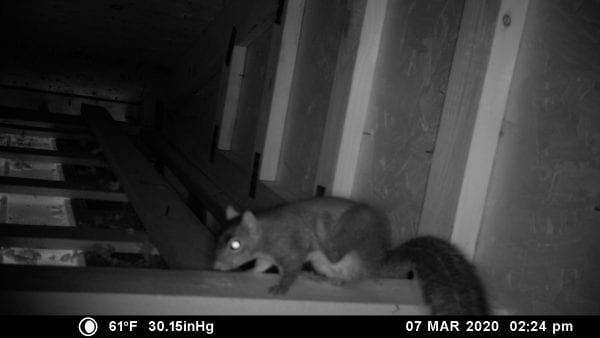
Figure 15. Game camera image
Proper cleanup of waste and damage as well as addressing any entrance areas around the home to prevent future problems is imperative and often can be overshadowed by the success of eliminating the current problem. Patch entrance holes with heavy hardware cloth or metal flashing, and replace any gnawed wood, siding, and fascia.
If squirrels inhabited an attic space, it is important to clean up any food debris or waste particles. These typically can be picked up by hand or vacuumed up. Soiled insulation can be identified by stains or odors and should be removed and replaced. Sanitize the attic space with an antimicrobial cleaner to remove the potential for any fungus or bacteria establishment.
Effectively managing nuisance squirrels requires patience and persistence on the part of the homeowner. Setting up a trap typically does not yield immediate positive results. The homeowner may need to try multiple methods or types of baits before having success. In some situations, the nuisance behavior may be exhibited by only one or a few squirrels. Therefore, removing those individuals from the population may provide relief, even if it is only temporary.
It is important to gauge trapping or exclusion success by frequently checking the sets. Game cameras are a great tool to use to identify whether a squirrel problem has been effectively managed (figure 15). Your county Extension office or state wildlife biologist also can be a resource and wealth of knowledge when working to manage a nuisance squirrel.
 Bence Carter, Regional Extension Agent, Forestry, Wildlife, and Natural Resources, Auburn University
Bence Carter, Regional Extension Agent, Forestry, Wildlife, and Natural Resources, Auburn University
New October 2020, Controlling Eastern Gray Squirrel Damage, ANR-2701

